- Category
- War in Ukraine
Top 5 Air Defense Systems That Proved Themselves in Combat in Ukraine
-5419bf19b6189702ce15b2c1f02484ed.jpg)
When 273 Russian drones swarmed Ukraine’s skies on the night of May 17–18, it was Ukraine’s air defense that held the line. Which systems have actually become lifesavers in this war?
The attack—the largest drone wave since Russia’s full-scale invasion began—came just hours before a scheduled Trump–Putin call on ceasefire talks. No ceasefire followed, but 128 drones were neutralized and 88 intercepted.
In April 2025 alone, Russian attacks killed over 200 and injured more than 1,000 civilians in Ukraine. The toll could have been far higher without Ukraine’s trusted sky defenders.
From apartment blocks and hospitals to power grids, transportation hubs, and also military assets, nearly every part of Ukrainian life is under threat. Only fast-evolving air defense technologies can keep up with Russia’s relentless missile and drone assaults. Some are homemade innovations. Others are among the most advanced in the world.
Ukraine’s air defense is a multi-layered strategy combining a diverse range of systems to intercept everything from drones to ballistic missiles. These systems are supported by radar coverage, intelligence, and frontline electronic warfare units. Together, they jam signals, crash drones, and stop strikes before they hit. Ukraine’s civil defense is also key, sounding real-time alerts through apps and broadcasts the moment a threat is detected.
Ukraine continues to strengthen its defenses—building its own systems, working with Western partners, and proving that every intercepted threat is not just a tactical win, but a defense of life itself. Here, we list the five that have proven themselves in real combat:
Ukraine’s Sting drone interceptor
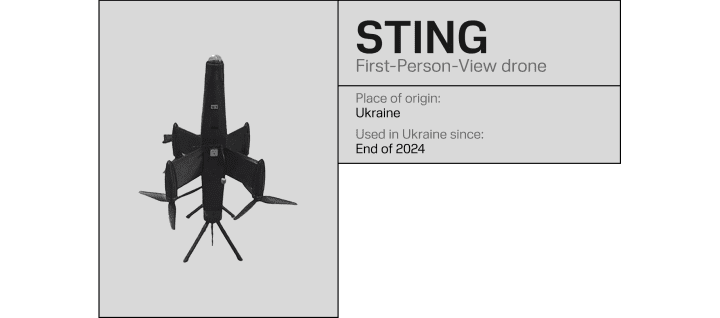
Ukraine’s “Sting” differs from what’s generally recognised as a typical air defense system. It’s a first-person view (FPV), drone designed to intercept Russia’s Iranian-made Shahed-136 attack drones.
Ukraine has begun deploying unique Sting drones, capable of intercepting Russian attack drones.
— UNITED24 Media (@United24media) October 24, 2024
READ: https://t.co/0nOE4G7xA9 pic.twitter.com/fnPZkTfiE9
Launched at the end of 2024 and developed by the Wild Hornets group, the Sting represents a shift in air defense strategy. It’s a low-cost agile solution to counter the growing threat from these loitering munitions.
Russia deployed 7974 drones in 2025 between March 1 and May 12, using an average of 110 Shahed drones during each attack, the Institute for Science and International Security reported. There were only six days in which Russia did not use Shahed-136 drones to attack Ukraine, highlighting the importance for Ukraine to develop its own defense capabilities.
This is the first and most effective drone of its kind currently in service in Ukraine.
Wild Hornets
The Sting can reach speeds of over 160 km/h (100 mph) and operate at altitudes up to 3,000 meters (10,000 feet), making it well-suited for tracking and intercepting Shahed-136 drones. Future enhancements include an artificial intelligence (AI) targeting system that will enable more precise tracking of enemy drones.
The Sting is significantly more affordable than the Shahed-136, with one unit costing dozens of times less. This makes it an effective and innovative asset in defending against Russia’s bombardments through cost-effective and agile solutions.
The Sting drone pursued and engaged a Shahed drone at high altitude striking the Shahed from below, disabling it mid-flight. This mission, reported earlier this week, marked the first known footage of the platform in action since its official launch.
The NASAMS system
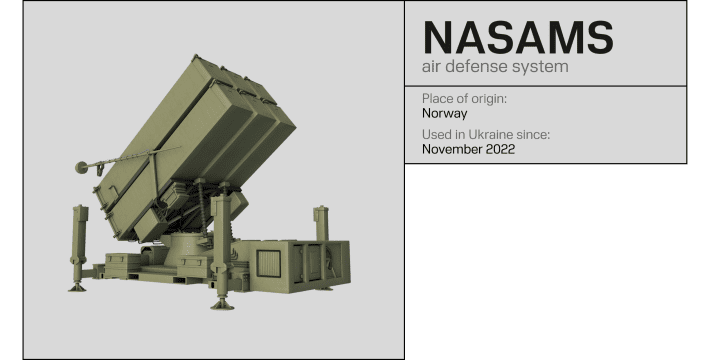
The NASAMS (Norwegian Advanced Surface-to-Air Missile System SAM) is a medium-range air defense system that uses both short—and medium-range air-to-air missiles. Built by Kongsberg and Raytheon, it is designed to intercept a wide range of aerial threats, including aircraft, helicopters, drones, and cruise missiles.
NASAMS missiles can strike targets from 2.5 up to 40km away, at altitudes between 30m to 16km, making them exceptionally versatile. Seventy-two missiles can be launched in just 2 seconds.
Its missiles have a self-destruct mechanism, reducing the risk of striking unintended targets. A key player in directly countering Russian propaganda, which claims that NASAMS cause widespread destruction.
NASAMS does fire relatively expensive AIM-120 AMRAAM missiles, one of the most widely used and manufactured missiles of its class. Earlier this year, Ukraine, with Kongsberg Defence, began negotiations to produce missiles domestically. This would give Ukraine the opportunity to mass-produce missiles, with its own technology, while reducing the cost.
As of March 2025, the NASAMS air defense system has destroyed about 900 air targets, and it is 94% effective, according to Colonel Per Steinar Tøyte, head of the Norwegian Air Force’s support group for Ukraine. Approximately 60% of these targets were cruise missiles, such as the Kh-101, Kh-555, Kalibr, Iskander-K, Kh-59, and Kh-69.
The system’s effectiveness has not just forced Russian warplanes into hiding — it has also exposed the glaring deficiencies in Russia’s air strategy.
Weapons Analyst
NASAMS have been crucial in protecting Ukraine’s key infrastructure from Russian missile and drone attacks, forcing Russia to shift tactics and rely more on drones and missiles, showcasing the system’s strong deterrent effect.
The Hero of Ukraine, Kyrylo Peretiatko, led an operation with his air defense unit that successfully intercepted 11 Russian cruise missiles during a single engagement in just less than two minutes, the Ukrainian Air Force reported in April 2025. To date, the unit has destroyed over 150 aerial targets, predominantly cruise missiles.
American Patriot air defense system
Patriot is one of the most advanced US air defense systems. It is a surface-to-air missile (SAM) system that can engage a wide range of threats, including aircraft, cruise missiles, and even ballistic missiles.
One Patriot missile, which is in short supply, costs around $3 million to launch, according to reports. Whereas one Shahed costs Russia $100,000-200,000 to launch, this is where systems like Sting are hugely beneficial, ensuring that Patriots are used for the most sophisticated threats.
Ukraine faces a shortage of both Patriot launchers and missiles. However, this week, it was announced that more are heading to Ukraine to support the nation in combating increasing Russian aerial threats. Ukraine has also repeatedly called for the localization of the production of launchers and missiles.
The Patriot has played an essential role in defending critical civilian infrastructure, such as electrical grids, hospitals, and other key facilities, from Russian missile attacks. Throughout its deployment in Ukraine, the Patriot has continued to successfully intercept a wide range of Russian weaponry.
The Patriot’s track record in Ukraine
In May 2023, the Ukrainian air force Patriot battery shot down five fighter jets and helicopters within minutes over the Bryansk region. Russia lost Su-34 and Su-35 aircraft, two Mi-8MTPR-1 air defense helicopters, and one Mi-8. Ukrainian Air Force spokesman Yuriy Ihnat called it a “Bryansk massacre”.
In May 2023, Ukrainian forces successfully intercepted and destroyed a Russian Kh-47M2 Kinzhal hypersonic missile over Kyiv using a Patriot system–marking the Kinzhals first interception. By the end of 2023, Ukraine had shot down 15.
The Kinzhal missile, also referred to as the “Dagger,” has been historically praised by Moscow as one of a series of "invincible" weapons. “It is highly effective and invulnerable to Ukraine’s air defenses,” Chief of Russia’s General Staff, First Deputy Defense Minister Valery Gerasimov, said. The dagger is not so invincible after all.
Russia’s S-400 Triumf fails to fulfill its name
The NASAMS and Patriot have proven their effectiveness. Russia’s Triumf SAM system, by contrast, has shown that its “prowess is exaggerated,” say the experts. In real combat conditions, its performance has prompted more questions than answers, being far from triumphant.
In 2017, US cruise missiles struck Syria’s air base near Russian S-400s, which failed to respond despite their 400 km range. In 2024, Israeli airstrikes on Iran overwhelmed S-300 and S-400 systems, which intercepted “few if any” missiles.
All this talk that we have secured the whole of Syrian airspace is artistic whistling.
Pavel Felgengauer
Moscow-based military analyst
Poland's Piorun MANPADS
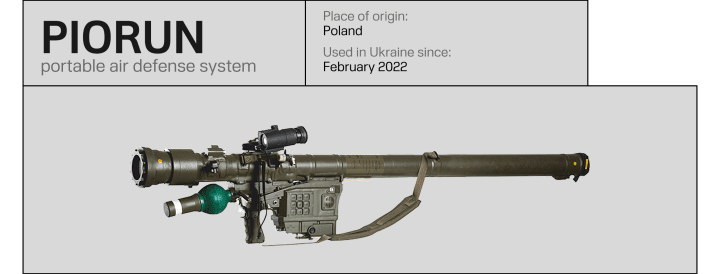
Piorun MANPADS (MAN-Portable Air-Defense Systems), developed and manufactured by Polish MESKO, is designed to destroy low-flying aircraft, airplanes, helicopters, and unmanned aerial vehicles.
This system uses a short-range missile with a warhead that can strike a flying target from 400 m to 6 km away, and at an altitude of 10m to 4km. Due to its success in Ukraine, the Piorun has become one of Poland’s export hits. This week, Belgium announced its purchase of these systems.
Piorun's most notable combat missions
In March 2023, the Spartan Brigade of the National Guard of Ukraine shot down a Russian Su-25 fighter jet from 4km away using a Piorun MANPADS, near Bakhmut.
In March 2023, Soldiers of the 10th Separate Mountain Assault Brigade “Edelweiss” downed a Russian Su-25 fighter jet at a 2-3km range in Berestove, Bakhmut District.
In February 2023, Ukrainian National Guard units destroyed a Russian Su-24 fighter jet and Su-25 ground-attack jets near Bakhmut. Maksym Baluta launched the Priorun, and he had previously shot down the first Russian aircraft in the Kharkiv region in March 2022.
In May 2022, the 95th Separate Air Assault Brigade of the Armed Forces of Ukraine shot down a Russian Ka-52 Alligator helicopter over the Kharkiv region.
In October 2022, Ukraine reported that the Piorun had shot down 9 Iranian Shahed-136 drones.
The video above reportedly shows the moment a Piorun downed a Russian cruise missile, likely either a Kh-101 or Kh-102.
There are several more successful instances of the Piorun in action, these combat missions highlight the effectiveness of the MANPAD against a wide variety of threats. Giving it a notable mention as a powerful asset to Ukraine’s arsenal.
German IRIS-T system
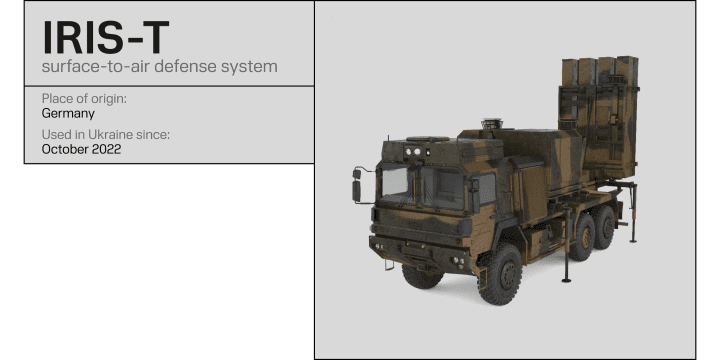
IRIS-T is a medium-range anti-aircraft missile system developed by Diehl Defence in 2014. It is designed to destroy cruise and ballistic missiles, aircraft, helicopters, and drones. The IRIS-T has allowed Ukrainian forces to protect critical and civilian infrastructure from persistent Russian aerial bombardments.
The IRIS-T reconnaissance station can detect targets up to 250km away. Its sophisticated radar homing and infrared guidance technology accurately engages a wide variety of aerial threats.
There are two installations of the system used in Ukraine: SLM is medium-range, and SLS is short-range. The IRIS-T SLM variant is designed to intercept cruise missiles, aircraft, and ballistic missiles. The IRIS-T SLS is particularly effective in intercepting low-flying threats, such as drones and short-range missiles.
Ukrainian Defense Minister Rustem Umerov and German defense company Diehl Defence—manufacturer of the IRIS-T system—announced the signing of a memorandum of understanding on March 9 to increase deliveries of these air defense complexes.
The IRIS-T systems have already demonstrated their effectiveness as a crucial part of Ukraine's air defense shield. The memorandum anticipates a threefold increase in the supply of missiles and air defense systems, said Rusem Umerov, Ukrainian Defense Minister.
IRIS-T SLM’s near-perfect interception rate
The commander of Ukraine’s separate anti-aircraft missile division, Oleksandr, says its crew shoots down 99% of all Russian air targets. The head of the IRIS-T SAM service, Dmytro, says that one of their launchers has destroyed more than 30 targets alone.
We spend one missile per one target. That is, the efficiency is one hundred percent. We even managed to destroy six enemy missiles with five of ours. The Russian missile exploded after being hit by our missile and destroyed another cruise missile with its debris.
Lieutenant Colonel Oleksandr
The Ukrainian soldiers noted that their air defense unit successfully destroyed 15 Russian cruise missiles in a single attack with the IRIS-T air defense system.
In a significant operation, Ukrainian IRIS-T SLM systems intercepted and destroyed 44 Kh-55 cruise missiles launched from Russian Tu-95MS bombers.
The IRIS-T air defense system has demonstrated its reliability as a cornerstone of Ukraine’s layered shield against aerial threats.
As Russia’s war continues, Ukraine continues to fight for peace across the nation. Systems like IRIS-T, Patriot, and NASAMS don’t merely intercept missiles; they protect homes, hospitals, and hope. Amid relentless waves of aerial attacks, these systems are not just holding the line—they're saving lives, securing skies, and giving millions a reason to believe in tomorrow.
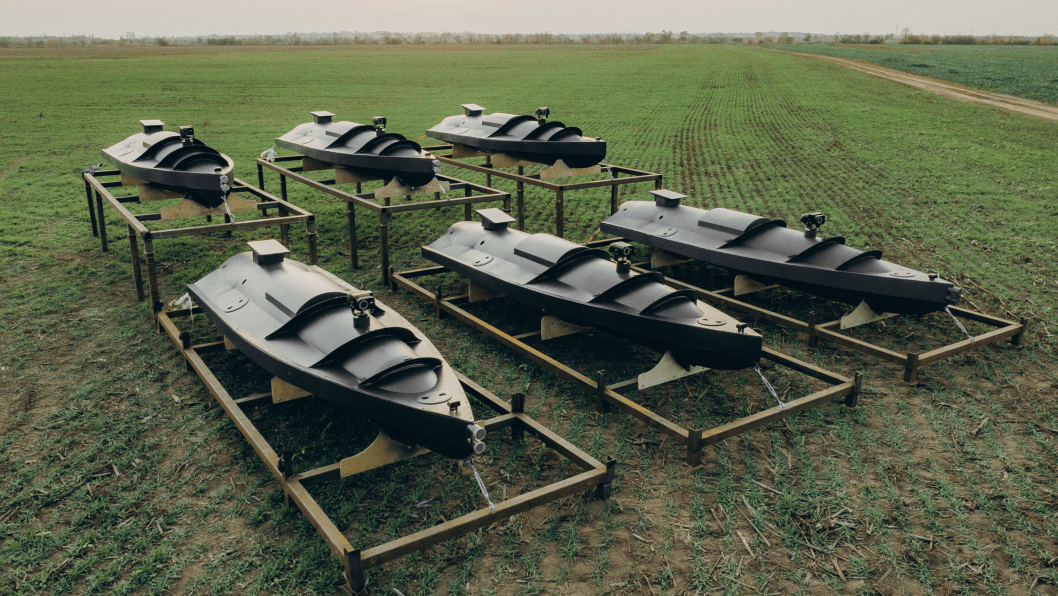
-46f6afa2f66d31ff3df8ea1a8f5524ec.jpg)
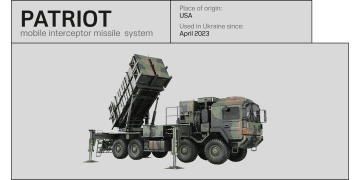
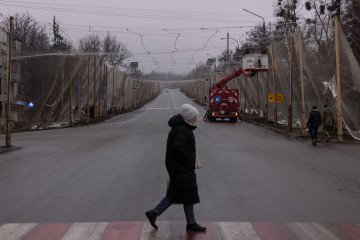
-f88628fa403b11af0b72ec7b062ce954.jpeg)
-b63fc610dd4af1b737643522d6baf184.jpg)

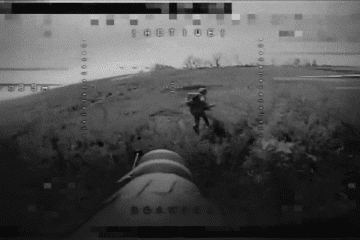
-29a1a43aba23f9bb779a1ac8b98d2121.jpeg)

-24deccd511006ba79cfc4d798c6c2ef5.jpeg)